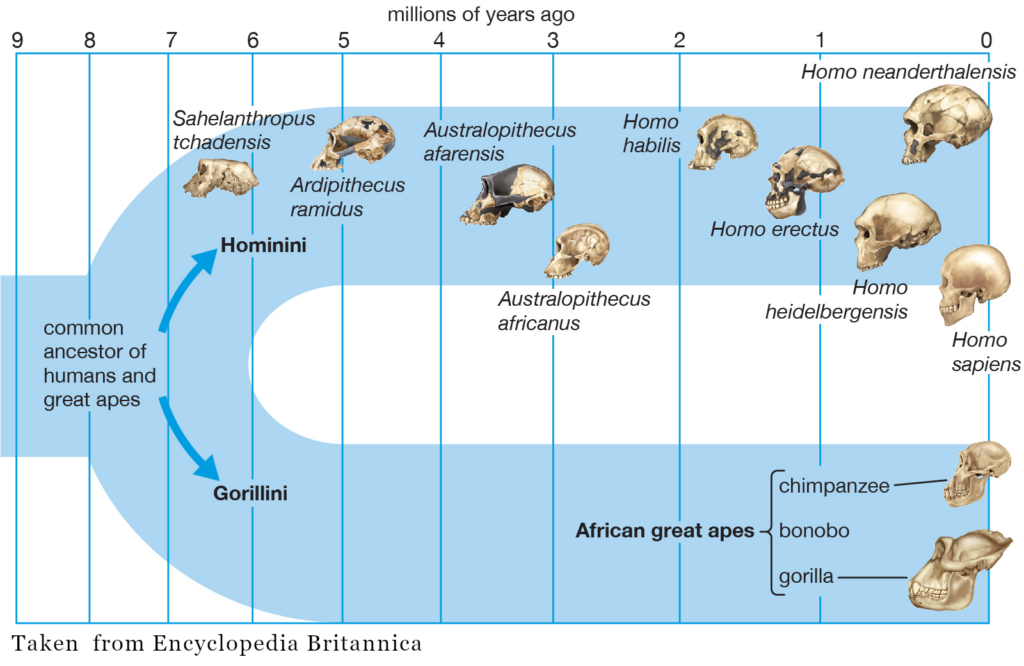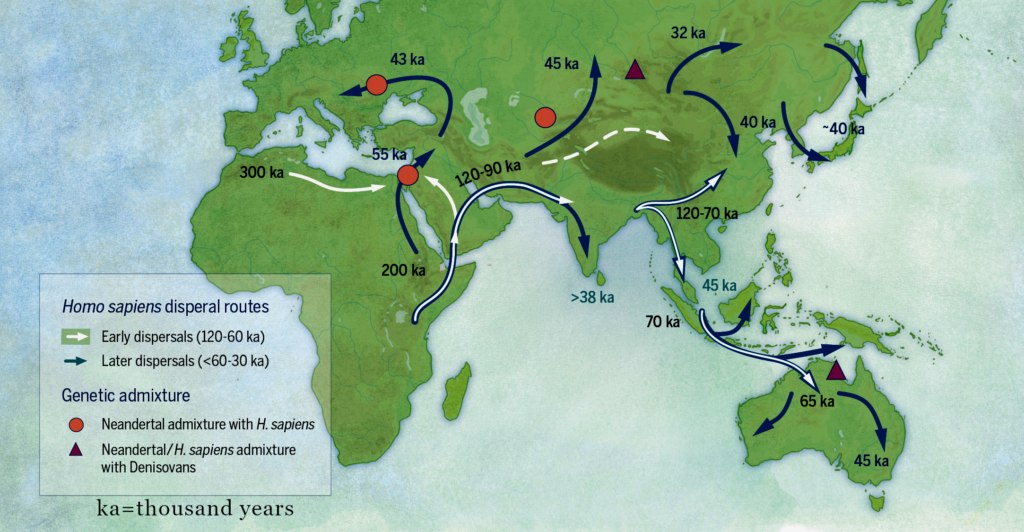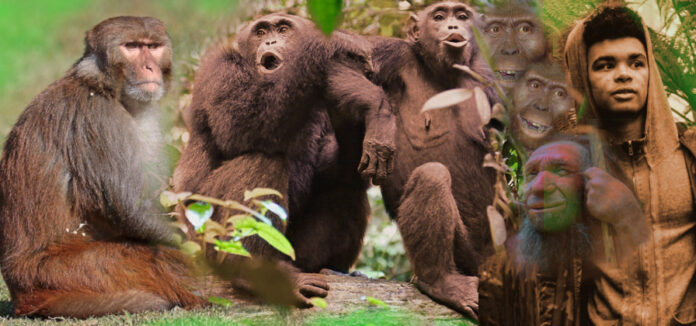Manoj Pandey*
If you have not updated yourself about how humans arose on earth, you might have a notion that humans evolved from monkeys. But anthropologists tell us, that is not the case. Even the earliest western observers of evolution, Charles Darwin being the most famous, did not say that the modern humans arose from monkeys. What they said was that primates such as monkeys, apes (chimpanzee, orangutan, gorilla) and humans had a common ancestor. Even the latest hypothesis says the same, though the time of divergence, the last common species, and other details keep changing as new fossils are discovered and examined with modern technological tools. The unravelling of the human genome has also thrown interesting insights into the tale of human evolution.
Not to speak of monkeys, even apes are quite far from our line of ancestry (see the image below), though not as far as birds, lizards and fish.

The latest scientific theory of human evolution
When human evolution is examined in detail, with new evidences coming in, a lot of mix-up takes place. New fossils have been found that are older than the earlier-known fossils but have more similarities with modern humans. Different lines of examination (e.g. detailed genetic make-up, overall skeleton structure, brain anatomy, skull and jaw formation, thigh bone development, behavioural modernity) lead to different possibilities. Someone has rightly said, human evolution does not conform to an evolutionary tree but is an evolutionary bush.
The latest understanding about the human evolution goes along these lines:
- Humans are related to apes, which are tail-less and usually more intelligent than monkeys.
- The common ancestor of apes and humans are supposed to be bipedal (walking on two feet) ‘animals’ that lived in Africa and Eurasia during 16-2.6 million years ago.
- Among the apes, chimpanzees are the closest relatives of humans. Both humans and chimps emerged from a common ancestor some 6.3 million years ago. The most probable common ancestor was either Kenyapithecus or Griphopithecus.
- Africa is supposed to be the continent where a great deal of evolutionary changes and migrations took place before the humans arose.
- It was earlier thought that hominins (pre-humans and humans that belong to genera such as Homo and Australopithecus) arose about 2.6 million years ago, but the latest research pushes back the date to 3.3 million years ago.
- A near-complete female skeleton – named Lucy – excavated from Ethiopia is a famous specimen of an Australopithecus. She looked almost like a human.
- The most common hominins whose fossils have been found from different parts of Africa and elsewhere are Neanderthals (Homo neanderthalensis) and Homo erectus.
- Perhaps one of the hominin species, Homo heidelbergensis, thrived in Africa for a long period. It branched into humans and two major hominins – Neanderthals and Denisovans. The use of fire and even cooking had been discovered by this likely ancestor of humans.
- The early humans (Homo sapiens) – one whose genetic makeup and anatomy have mostly remained the same till date – arose 3,15,000 years ago. Some call these early humans as a sub-species (Homo sapiens idaltu) to differentiate them from modern humans (Homo sapiens sapiens), but there is no consensus on that.

- Against the earlier belief that humans became a dominant species on earth because they discovered stone tools, it is now known that primitive tool making and socialization were in existence long before the humans arose.
- In East Africa, a stone tool making technology, called Acheulean (pear-shaped hand axes made of stone), is supposed to have arisen 1.76 million years ago. It was common among hominins and was spread across Africa, West Asia, South Asia, East Asia and Europe. It lasted for many millennia, ending in different periods, some as near as 57,000 years ago.
- A recent study estimates that for about 1,00,000 years, Neanderthals and early humans both used the Acheulean tools.
- It was thought till recently that humans occupied the territories earlier inhabited by the Neanderthals and other hominins. It was later established that they co-existed till as recently as 40-50,000 years ago.
- While the other hominins kept on migrating out of Africa quite early, humans are supposed to have remained mostly in Africa before migrating outside. They too started migrating, perhaps from different areas and in many waves. It was earlier thought that the human migration out of Africa happened around 60,000 years back. However, it is now fairly established that humans started branching out to West Asia, South Asia, East Asia and Europe 1,20,000 years back.
- Earlier it was thought that major human evolution happened in East Africa. A new fossil, of 3,15,000-year vintage found in North Africa has given rise to a new hypothesis that early humans arose in different parts of Africa, almost simultaneously. Some other archeological finds substantiate this hypothesis.
- If earlier it was thought that African coasts provided a great place for humans to thrive, and humans went inland later on, a recent find in the inner parts of Kalahari Desert – of decorative crystals and shells belonging to 1,05,000 years back shows that humans inhabited and thrived in inland Africa probably before the shore-dwellers. The presence of sea shells 600 miles from the sea coast and crystals (a non-utilitarian object) shows they exhibited a high level of social behaviour.
- No ancestral species from which humans arose survive today, nor do any cousin species. It appears that different branches of pre-humans evolved, sometimes independently, and out of them many might have become extinct without giving rise to a more evolved species.
- A number of mutations and adaptations – both, in isolation and population admixing – led to formation of different human races.
- DNA analysis of modern humans has established that there was interbreeding of humans with Neanderthals and Denisovans, multiple times. For example, the present-day Eurasian population has around 2% of their genome from Neanderthals; the Oceania’s original inhabitants have up to 8% of their genome from Denisovans; there are instances of genetic admixture in the African population.
- Human, Neanderthal and Denisovan DNAs are similar to a large extent; however, hundreds of genes are different and some of them seem to have mutated in a way that has given humans a more powerful brain and some other characteristics such as skeletal structure suitable for bipedalism, lower need for water, and a longer sex-life. The exact working of some fossil genes has been studied by making them function in lab-grown human tissues, and these studies are still underway.
Summing up
Some one-liners on how humans evolved, for a quick summary:
- Humans did not arise from apes, forget monkeys.
- Much before humans, human-like beings used stone tools and showed complex social behaviour.
- None of our ancestral species or cousin species survive today.
- Modern humans seem to have originated in different parts of Africa and also had interbreeding with non-human species.
Are we evolving still?
Yes! A resounding yes and according to this Science Magazine article, with genomic revolution, researchers have actually successfully tracked the population-level genetic shifts that mark evolution in action. Quoting two studies, the article says that our genomes have changed over centuries or decades contrary to what we thought earlier that evolution requires thousands or millions of years. If you are interested in more information on this subject, visit the links given below in the references.
References:
- A handful of recent discoveries have shattered anthropologists’ picture of where humans came from, and when
- Analysis of Human Sequence Data Reveals Two Pulses of Archaic Denisovan Admixture
- Could humans ever be venomous?
- Human evolution
- Innovative Homo sapiens behaviours 105,000 years ago in a wetter Kalahari
- Neanderthal and early modern human stone tool culture co-existed for over 100,000 years
- Human are Still Evolving – and We can Watch it happen
Terms used: Different zoological terms have been used differently in scientific literature owing to lack of consensus. This article uses their most accepted forms as follows: Homimin is used for the tribe of human-like beings and includes the genus Homo as well as some others; sapiens is one of the species within genus Homo; neanderthalensis (Neanderthals) and denisova (Denisovans) are taken as species of the genus Homo. Modern humans belong to the species Homo sapiens.

*About the author: This article has been contributed by Manoj Pandey. He does not like to call himself a rationalist but insists on scrutiny of apparent myths as well as what are supposed to be immutable scientific facts. Please don’t take the views of the author as the views of Raag Delhi.



